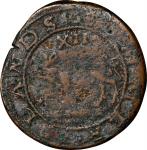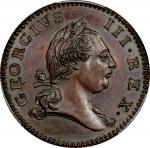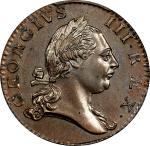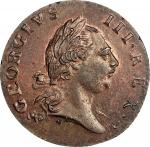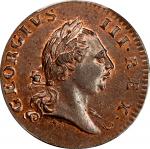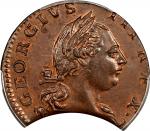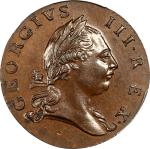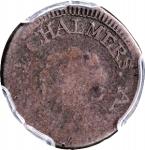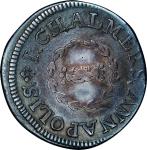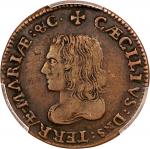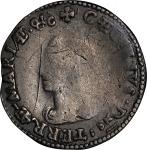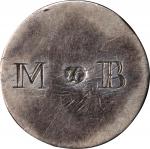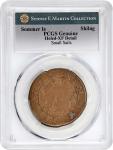Undated (ca. 1616) Sommer Islands Shilling. BMA Type I, W-11460. Small Sails. EF Details--Holed (PCGS).105.0 grains. Aside from its ancient flaw, this is one of the finest Sommer Islands shillings around, ranking among the very sharpest and boasting the best surfaces of any weve encountered. Choice light brown with surfaces that are barely granular and retain some gloss. Well centered and nicely struck on a broad planchet, with a bold and complete hogge on the obverse and superb ship on the reverse. The obverse legends are nearly complete, with SOMM ISLANDS complete and crisp; fortunately (?) the hole was placed at the most softly struck portion of the perimeter. The hole misses the design on the reverse, and the ship is surrounded by nearly a full complement of beading, stretching from 2 to 11 oclock. The obverse is ideally centered, the reverse is trivially aligned to the upper right. The softness below center on the reverse is due to die swelling, commonly seen on this variety. The die state is not as advanced as sometimes encountered. A Sommer Islands shilling like this without a hole would be an unimaginably great coin, but even with it, this is a very desirable property. <p><p>The European discovery of the Sommer Islands, or Bermuda Islands as they are known today, allegedly occurred in 1505 when they were visited by a Spaniard named Juan de Bermudez. British involvement did not come about until 1591, and then by accident, when Henry May, Captain Lancaster and others in their party were shipwrecked on the islands. Another, more significant shipwreck came in 1609 when nine ships carrying approximately 500 people bound for Virginia was driven ashore on the Bermuda Islands by a fierce hurricane. The castaways, who included Sir George Somers, found a ready supply of food in the form of the islands hog population. The first of these animals either found their way to the islands when Bermudez released some during his 1505 visit to serve as a food supply for shipwrecked mariners or were accidentally introduced by escaping from one of Bermudez ships when the Spaniard himself was stranded there during a later visit in 1532. Details of this incident are scarce and often conflicting, as they are with so many aspects of Sommer Islands coinage history. Regardless, the hogs were so important to the shipwrecked English colonists in 1609 that they became closely associated with the islands, hence the depiction of a hog on the obverse of the later coinage issue.<p><p>Although most of the English party managed to leave the islands in 1610 and make their way to Virginia, as originally intended, Somers returned later that year. He died shortly after arriving, on St. Georges Island, and the islands became known as the Sommer Islands in his honor. A larger party arrived from Virginia in 1612, this one spearheading a venture by a group of approximately 120 persons affiliated with the Virginia Company who had obtained a patent from King James I giving them authority over the area. From July 11 of that year until 1615 the islands were governed by Richard Moore and a series of short-lived successors under the umbrella of the Virginia Company. On June 29, 1615 the Bermuda Company was chartered as a separate entity, thereby ending the islands relationship with Virginia and the company which governed that colony.<p><p>Under the direction of a new governor Daniel Tuckar who arrived in the middle of May 1616, initiatives were taken to help the islands meet expectations that they would eventually develop into a thriving settlement and port of call. Authorized by royal patent on June 29, 1615 upon the founding of the Bermuda Company, the Sommer Islands coins did not reach the islands until Tuckars administration. Examples were struck in denominations of twopence, threepence, sixpence and shilling, but as the planchet stock used for each was brass as opposed to precious metal, the coins had exchange value as fiat currency but little intrinsic worth. Even the fact that most examples were given a light wash or coating of silver did not promote their wider acceptability, and the coins traded exclusively in the Sommer Islands, and then again mostly at the company storehouse, where colonists exchanged them for supplies. Given that other commodities such as tobacco also served as useful mediums of exchange on the islands, the coins usefulness was short lived and by early 1618 they had been largely phased out. Specialist in Bermuda coinage Mark Sportack proposes that these coins were so detested late in their circulating life that many were thrown away as useless trash, and the mass deposit found at Castle Island in the 1990s supports this thesis.<p><p>Widely regarded as the first coins struck for the English colonies in the New World, the Sommer Islands pieces have been taken into the wider family of American colonial coinage by advanced numismatists. Prior to the late 20th century all denominations were considered extremely rare. Thanks to the advent of modern metal detecting equipment, however, many ground finds have been recorded since the early 1990s. On the other hand the total number of pieces discovered to date remains limited, the extant population in no way large enough to meet current (to say nothing of future) numismatic demand. The threepence, in particular, remains very rare and, given the manner in which most examples were discovered, Sommer Islands coinage as a group is extremely difficult to locate with overall smooth, problem-free surfaces. Most examples are extensively corroded, many to the point where they are barely identifiable as to type.<p><p>The Small Sails variety, offered here, is the more frequently encountered Sommer Islands shilling. It is also the most readily obtainable Sommer Islands coin irrespective of denomination or variety although, once again, we must stress that all issues in this series are rare in an absolute sense. In fact, just 12 distinct examples of the Small Sail shilling were enumerated in the 1997 BMA census of Sommer Island coinage. Despite the omission of this piece and other recent additions to the market, this variety remains rare enough and popular among enough different market segments (i.e. Bermudans, Caribbean collectors, British Commonwealth collectors, and American colonial enthusiasts) that its offering should be viewed with great relish, as a desirable example of this early New World issue.PCGS# 6.From the Sydney F. Martin Collection. Earlier from our (Stacks) sale of October 2003, lot 2001; Lawrence R. Stack Collection, November 2006.

